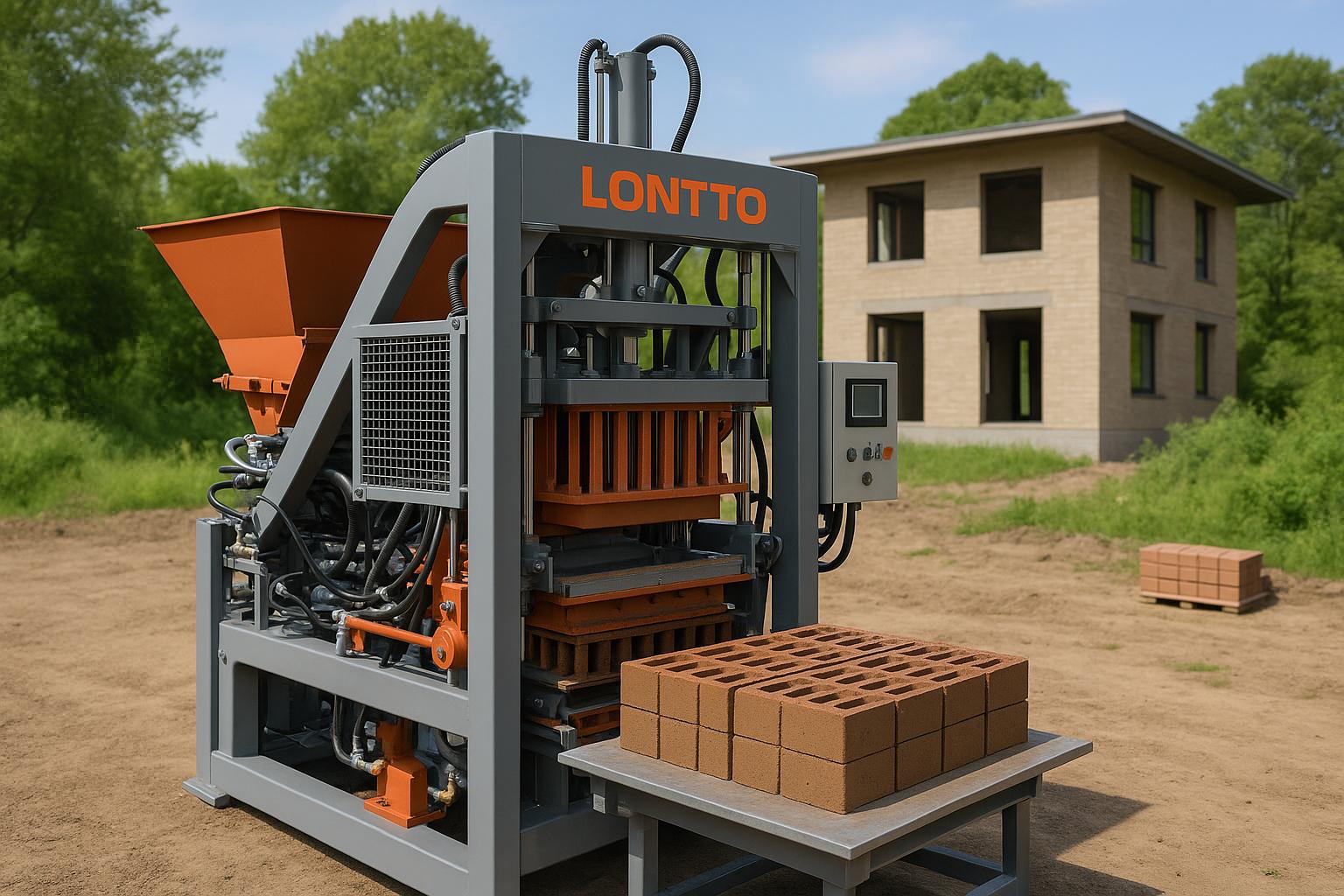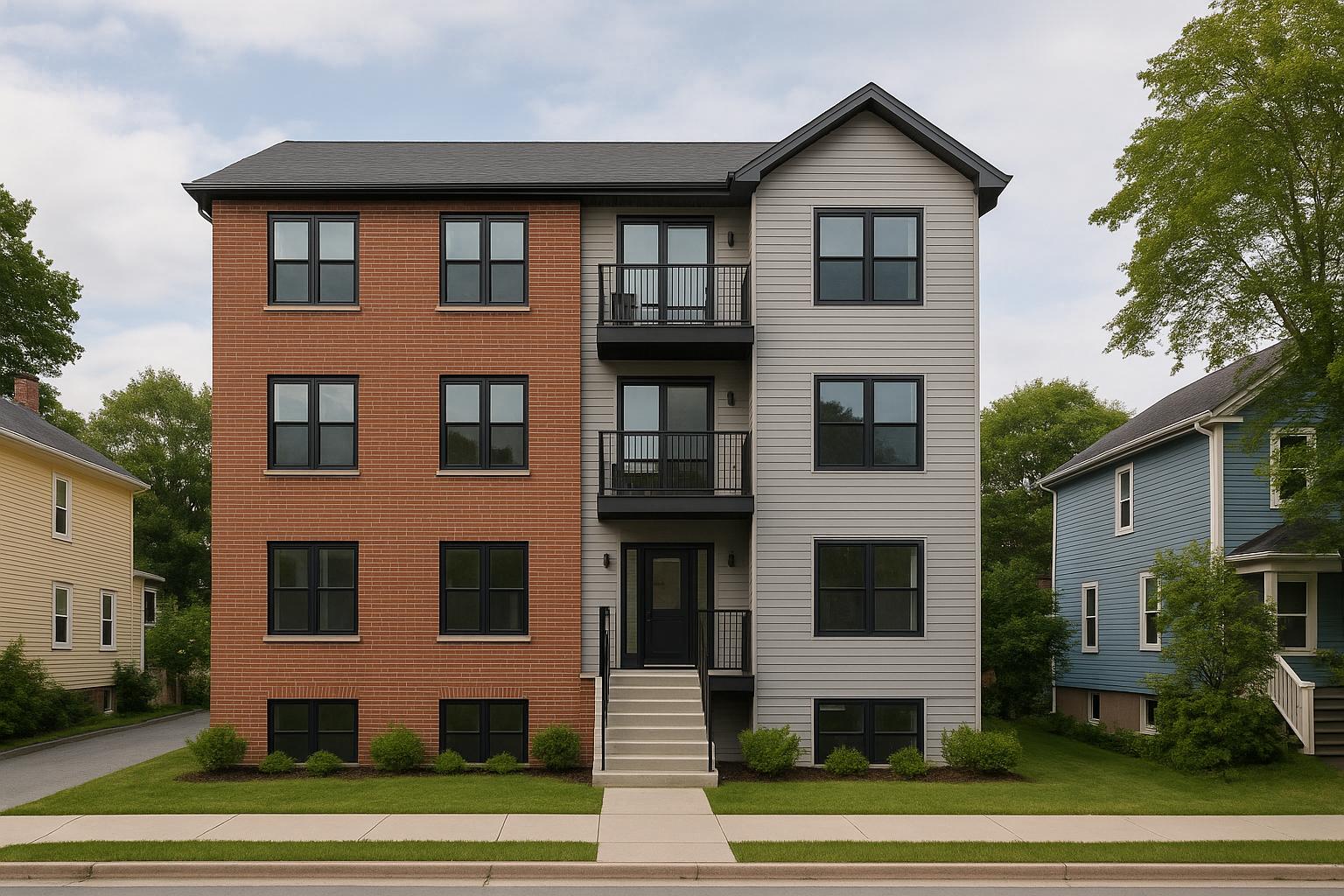Nova Scotia is an attractive location for multi-unit rental developments, particularly at the Portland/Wyse intersection in Dartmouth. Here's why:
- Strong Market Demand: Steady population growth, low rental vacancy rates, and a shift toward modern, energy-efficient housing.
- Financial Opportunities: Monthly rents of CA$1,950–CA$2,100 per unit can yield annual returns between 12%–20%. Programs like CMHC MLI Select offer 95% financing with 50-year amortization for qualifying projects.
- Lower Construction Risks: Integrated design-build methods reduce costs, eliminate delays, and ensure fixed pricing - CA$160,000–CA$200,000 per unit.
The Portland/Wyse area combines excellent transit connectivity, local incentives, and growing demand for mixed-use developments. By choosing efficient construction methods and leveraging financing programs, property owners can achieve predictable returns while meeting modern rental needs.
Nova Scotia Effectively Removes HST on New Rental Housing Development
Market Opportunity at Portland/Wyse Intersection
The Portland/Wyse intersection in Dartmouth sits in a prime area of growth, with strong demand for rental properties. This location offers a chance for property owners to develop multi-unit retail and residential projects that not only align with market needs but also provide steady financial returns.
Demand for Multi-Unit Retail and Residential Projects
The Halifax Regional Municipality continues to see steady population growth paired with low rental vacancy rates, making the Portland/Wyse area particularly appealing for development.
This location benefits from excellent connectivity: direct access to Highway 111, the MacKay Bridge, and multiple transit routes makes it easy for residents to commute to Halifax, Bedford, and major employment hubs. For many renters, this connectivity supports a car-free lifestyle, which is becoming increasingly attractive.
Mixed-use developments - combining ground-floor retail with residential units - offer a unique advantage. Property owners can tap into both commercial and residential markets, creating diversified income streams.
The area is also seeing a demographic shift, with a growing number of young professionals working in sectors like tech and healthcare. These renters are drawn to energy-efficient, modern living spaces that include conveniences such as in-suite laundry and parking.
Additionally, much of the housing stock in the area consists of older single-family homes and aging apartments. This creates an opening for property owners to introduce purpose-built rental units that meet modern standards for quality and efficiency, addressing the expectations of today’s renters.
Local Government Incentives and Zoning Benefits
Municipal policies in the Portland/Wyse area have evolved to encourage multi-unit developments. Flexible zoning regulations and streamlined approval processes make it easier to launch new projects. Added incentives, such as property tax deferrals during construction and reduced assessment rates, can improve cash flow for developers.
Recent upgrades to essential infrastructure - like water, sewer, and road systems - further enhance the appeal of the area. On top of this, programs like the CMHC MLI Select initiative offer financial perks. For example, projects meeting CMHC MLI Select standards can qualify for 95% financing with a 50-year amortization period. With construction costs for these buildings averaging around CA$200,000 per unit, these terms significantly improve project feasibility.
Integrated design-build approaches also simplify the development process. By consolidating all professional services under one contract, this method minimizes delays and helps property owners transition quickly from planning to occupancy. Combined with the financial and regulatory benefits available, this streamlined construction approach makes it easier to bring new projects to life in this thriving corridor.
Construction Costs and ROI Projections
Breaking down the construction costs and potential returns for multi-unit projects at Portland/Wyse provides clarity for investors. Success hinges on balancing upfront expenses with long-term rental income. Let’s dive into the per-unit construction costs and the projected returns.
Per-Unit Construction Costs
In Nova Scotia, construction costs for rental properties vary depending on the quality and construction approach. At Portland/Wyse, two main options are available:
- Standard Construction: This option costs approximately CA$160,000 per unit and includes tenant-friendly features like triple-pane windows, ductless heat pumps, quartz countertops, engineered hardwood floors, and custom millwork. These upgrades aim to attract tenants while keeping maintenance manageable.
- CMHC MLI Select Construction: At CA$200,000 per unit, this option adds energy efficiency upgrades that exceed building code requirements by 40%. The higher cost comes with significant financing perks, such as 95% financing and 50-year amortization terms, which can offset the initial expense.
The timeline also plays a critical role in managing costs. A fragmented construction process can stretch over 12–18 months, adding carrying costs. However, an integrated design-build approach can cut the timeline to just 6 months, reducing costs and enabling faster revenue generation.
For a typical 4-unit building, construction costs range between CA$640,000 and CA$800,000, depending on the chosen option. Next, let’s see how these costs translate into rental income and returns.
Rental Yield and ROI Analysis
Rental income projections for new multi-unit properties at Portland/Wyse show strong earning potential. Modern 2-bedroom units in this area rent for CA$1,950–CA$2,100 per month, thanks to the location’s connectivity and the appeal of purpose-built rentals.
For a 4-unit building generating roughly CA$8,000 in monthly rental income (around CA$96,000 annually), ROI falls between 12–20%, depending on the financing model.
The CMHC MLI Select financing option significantly enhances returns by requiring only a 5% down payment. On an CA$800,000 project, the owner’s cash investment is reduced to CA$40,000, compared to CA$160,000 (20%) with traditional financing. This lower upfront cost boosts returns and creates immediate cash flow.
Additionally, the Premium Rental Ready package, which costs CA$15,000 per unit, eliminates the usual 60-day gap between project completion and rental income. It includes appliances and smart home features, allowing owners to start collecting rent right away.
Cost Model Comparison
The table below highlights how construction and financing choices shape investment outcomes:
| Construction Type | Cost Per Unit | 4-Unit Total | Owner Down Payment | Monthly Rental Income | Annual ROI Range |
|---|---|---|---|---|---|
| Standard Construction | CA$160,000 | CA$640,000 | CA$128,000 (20%) | CA$7,800–CA$8,400 | 12–16% |
| CMHC MLI Select | CA$200,000 | CA$800,000 | CA$40,000 (5%) | CA$7,800–CA$8,400 | 16–20% |
While the CMHC MLI Select option requires higher per-unit construction costs, it dramatically reduces the owner’s cash investment, offering a leverage ratio of 20:1 compared to the 5:1 ratio with standard financing. This allows property owners to either build more units with the same capital or enjoy higher returns on their investment.
Delays in construction can be costly, with each month potentially losing up to CA$8,000 in rental income. Choosing a reliable construction partner who can deliver on time is crucial for maximizing profitability.
sbb-itb-16b8a48
Integrated Design-Build vs Traditional Construction
At Portland/Wyse, the construction method you choose plays a key role in defining your project's budget, timeline, and rental income. As highlighted earlier, the integrated design-build approach offers distinct advantages that can significantly impact these factors. Let’s explore how it compares to traditional construction methods.
Problems with Traditional Construction
Traditional construction relies on a fragmented system where property owners must juggle multiple professionals - architects, engineers, contractors, subcontractors, and project managers. This disjointed approach often leads to several recurring problems:
- Budget Overruns: Fragmentation causes inefficiencies, resulting in cost overruns of 30–60%. Owners are often forced to make expensive compromises or secure additional funding to cover unexpected expenses.
- Timeline Delays: Projects that could take about 8 months often stretch to over 18 months due to poor coordination and mismanagement.
- Coordination Failures: Miscommunication and scheduling conflicts are common, leaving property owners to resolve disputes instead of focusing on progress.
Benefits of Integrated Design-Build
The integrated design-build model eliminates these challenges by consolidating all professionals under a single, accountable company. This unified approach streamlines every phase of the project, offering several key benefits:
- Fixed-Price Construction: With Helio Urban Development, property owners receive a locked-in price of CA$160,000 per unit before construction begins. Completed projects have consistently avoided any cost overruns.
- Guaranteed Timelines with Penalties: Helio ensures construction is completed within 6 months. If deadlines are missed, Helio pays penalties of up to CA$1,000 per day, providing financial reassurance.
- Efficient Coordination and Transparency: The integrated team handles all scheduling, inspections, and deliveries to keep the project on track. Real-time updates, including daily photos via a project portal, give owners full visibility without needing to visit the site.
- Rigorous Quality Control: A Professional Engineer performs five inspections, and the final inspection is conducted by an inspector chosen by the owner. This thorough process is backed by a 2-year warranty, ensuring top-tier construction standards.
Construction Method Comparison
| Aspect | Traditional Fragmented | Integrated Design-Build |
|---|---|---|
| Budget Certainty | 30–60% overruns common | Fixed price with CA$0 overruns |
| Timeline Reliability | Projects often stretch to 18+ months | 6 months guaranteed |
| Accountability | Multiple contracts, divided roles | Single point of accountability |
| Coordination | Owner manages complexities | Professionals handle scheduling |
| Quality Control | Varies by contractor | Triple verification system |
| Risk Management | Owner bears most risks | Company assumes liability |
By opting for the integrated design-build model, property owners gain control and predictability. They know exactly how much they’ll spend, when they’ll start earning rental income, and the quality they can expect. This certainty is especially critical for maximizing returns at Portland/Wyse, where delays or budget overruns can directly affect the bottom line.
For those planning 4+ unit developments, the choice between a fragmented system and an integrated design-build approach can determine whether you achieve a projected 12–20% annual ROI or face prolonged financial uncertainty. Up next: practical tips for boosting rental income through smart design choices.
Practical Steps for Property Owners
If you’re planning a multi-unit retail and residential project at Portland/Wyse, your success will depend on three main factors: smart design, effective financing, and choosing the right construction partner. Using an integrated design-build approach can help you maximize the potential of your property and navigate the complexities of such projects.
Maximizing Rental Yields Through Smart Design
The design of your property directly impacts rental income. To attract tenants willing to pay higher rents, consider incorporating energy-efficient systems like ductless heat pumps and triple-pane windows. Adding desirable in-unit amenities, such as laundry facilities or smart home features, can also set your property apart.
Pay attention to the layout of your units. Well-thought-out configurations, such as properly sized two-bedroom units, can appeal to a broader pool of potential tenants while ensuring your rental rates remain competitive with market standards. Smart design isn’t just about aesthetics - it’s about creating spaces that tenants find functional and appealing.
Using Financing Programs for Better ROI
Financing can make or break your project’s profitability. Programs like the CMHC MLI Select offer up to 95% financing and extended amortization periods, which can significantly improve cash flow and enhance your return on investment. These programs often require meeting energy efficiency standards, but the long-term benefits - such as lower operating costs and added property value - make it worth the effort.
To take full advantage of these financing opportunities, start the application process early, ideally during the planning phase. This ensures you have the financial backing you need to move forward with confidence.
Choosing the Right Construction Partner
Your choice of construction partner can either streamline your project or create unnecessary headaches. Look for a builder with a strong track record in multi-unit projects and a reputation for delivering results. An ideal partner will offer:
- Fixed-price contracts to keep your budget on track.
- Timeline guarantees, complete with penalty clauses to protect you from costly delays.
- Comprehensive inspections and warranties to safeguard the long-term value of your investment.
- Integrated team capabilities to simplify communication and reduce coordination challenges.
Building Smart for Long-Term Success
The Portland/Wyse intersection offers a standout opportunity for developing multi-unit rental properties. With strong market fundamentals in play, this location stands out as an ideal spot for such projects.
However, success hinges on execution. Traditional construction methods often come with fragmented teams, budget overruns ranging from 30% to 60%, and timelines that can stretch from 8 months to well over 18 months. These challenges can eat into profitability. An integrated design-build approach offers a solution by providing fixed-price contracts, guaranteed timelines, and single-point accountability - eliminating many of the risks associated with traditional methods.
For property owners, costs are predictable: CA$160,000 per unit for standard builds or CA$200,000 per unit for CMHC MLI Select qualifying projects. These figures not only provide cost certainty but also open doors to financing options that include 95% financing and extended amortization periods. This financial predictability is a cornerstone for ensuring long-term profitability while minimizing construction risks.
To avoid the pitfalls of uncertainty, property owners should insist on guarantees. Look for contracts that include timeline assurances with penalty clauses (up to CA$1,000 per day for delays), thorough quality inspections, and daily progress updates. These measures ensure projects stay on track and meet expectations.
Smart design choices also play a huge role in success. Energy-efficient features, high-quality finishes, and functional layouts not only attract premium tenants but also reduce ongoing operating costs. When paired with strategic financing and a reliable construction partner, these elements help create rental properties that generate strong cash flow from day one and appreciate in value over time.
The time to act is now. By planning carefully and embracing an integrated construction approach, property owners can build wealth while addressing Nova Scotia’s growing housing needs.
FAQs
What are the benefits of choosing an integrated design-build approach for multi-unit retail projects at the Portland/Wyse intersection?
The design-build method brings a range of advantages for property owners planning multi-unit retail developments at the Portland/Wyse intersection. By merging the design and construction stages into one cohesive process, this approach accelerates project timelines and minimizes the chances of delays or miscommunication.
Another key benefit is cost predictability. With fixed pricing and a single point of accountability, property owners can sidestep unexpected expenses and potential disputes. Plus, the collaborative nature of design-build fosters better communication among teams, ensuring the project aligns smoothly with Nova Scotia's changing regulations. For property owners, this translates to more consistent and profitable results, tailored specifically to the local market.
What makes the Portland/Wyse intersection in Nova Scotia an ideal location for multi-unit developments?
The Portland/Wyse intersection in Nova Scotia stands out as a prime spot for multi-unit developments, thanks to its zoning perks. These include density bonuses and simplified approval processes, which pave the way for higher occupancy rates and more adaptable building designs. For property owners, this means an opportunity to optimize rental income with fewer hurdles.
On top of that, there are financial incentives like federal grants and energy rebates that can significantly cut down initial construction costs while boosting long-term profitability. Together, these advantages make Portland/Wyse an appealing option for those aiming to develop rental properties with strong returns on investment.
What kind of returns can property owners expect with CMHC's MLI Select financing, and how does it compare to traditional options?
CMHC's MLI Select financing offers a way for property owners to cut monthly payments by around 12% and reduce down payment requirements compared to standard loans. This can be a helpful tool for boosting cash flow and managing debt more effectively.
That said, changes are on the horizon. By 2025, premium rates are set to climb from 2.55% to as much as 7.7%. For highly leveraged projects, this could impact return on investment. While insured financing still provides perks like lower interest rates, these increases make it essential to evaluate each project's financials carefully to ensure the numbers work in your favour.



